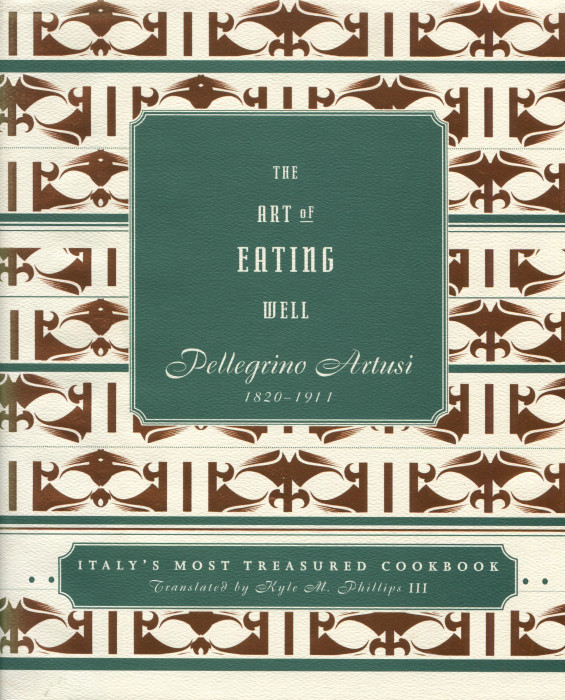This may be the oldest TBT cookbook I’ve ever done. First published in 1891, The Art remains in print and is widely used. In Italy, there have been over 111 editions and in almost every home kitchen you can find a copy of one edition or another.
Author Pellegrino Artusi was an upper class silk merchant in Florence whose passions in life were fabrics and food. His book was originally titled The Science of Cookery and The Art of Eating Well. It was compendium of the recipes he had served his guests, although it is unlikely that he spent many hours himself in the kitchen. He could afford superior cooks and grand ingredients. He ate, he enjoyed and he wrote.
Once written, Pellegrino could not find a publisher. So he published the book himself and over the years doubled the number of recipes. This English edition, from 1996, is 500 pages long and filled with authentic excellence of the times.
Yes, The Art is filled with cooking from a very different time. These are the recipes from a kitchen, one you might recognize ala Downton Abbey, where cooking is done over a fire, real fire. There are knives and a mortar and pestle but no blender or food processor. Cooking then, the cooking described in this book, was hand labor over an extended period of time. The recipes here are not arduous, but they are art and impose all the connotations that “art” imposes.
Just the chapter titles forecast the different perspective about food that shines in The Art of Eating Well:
- Broths and Sauces
- Soups
- Starters
- Sauces
- Eggs
- Fried Dishes
- Entremets
- Stews
- Chilled Dishes
- Greens and Legumes
- Fish
- Roasts
- Desserts
- Syrup
- Preserves
- Liqueurs
- Ice Creams
Look at that emphasis on dairy and eggs and sweets. A whole chapter for eggs, another for ice creams, and then desserts and syrups and liqueurs. There are recipes here to greet you to the table, then surround each dish in liquid layers.
What are those Entrements? By the time this book was written, this French idea of little dishes served between the more prominent ones was an idea that had faded in Italy. Still it’s a fun journey to see these little, tapas-like ideas:
Salted Anchovy Crackers
Cornmeal Polenta with Sausages
Ricotta Tarts
Puff Pastry with Meat Fillings
The Syrup chapter is devoted to very sweet concoctions meant to be diluted with water and drunk, but only —Artusi advices —after the previous meal has been thoroughly digested:
Raspberry
Currant
Maraschino Cherry
Sapa [White Grape must achieved after a day of crushing and fermentation]
You’ll find the recipes here to be simply titled, like Stuff Pork Loin. There’s nothing there to immediately reach out, shake you, and announce “Make Me Now.” But then you read the ingredients and discover that the pork loin is stuffed with sautéed veal plus prosciutto and mortadella. Those meats are converted into a paste using Parmigiano, egg and beef marrow. The paste goes into deep slashes cut into a pork loin and the assembly is cooked “over a slow fire” noting that “three hours should be long enough.”
When was the last time you purchased beef marrow?
In these recipes, the amount of ingredients are sometimes only approximate. The temperatures are suggested by adjective — and not thermometer — and the timing is a reminder for the cook who already has kitchen experience.
This is not a beginner’s book at all. You will have to read, interpret, and use some common sense. There is even an occasional alert. For the baba dessert, the headnote warns, that the dish “requires care and patience to make it.” I’m not putting in this warning to you to scare you off. I am saying that this book is one to approach on a weekend afternoon when you have the time for that care and patience, suggested for this one recipe to be sure but I find really wise for most of the dishes here, dishes like:
Pappardelle with Rabbit Sauce
Genoese Sauce for Boiled Fish with Hard-Boiled Eggs and Olives
Fried Peaches with a Batter of Brandy, Eggs, and Ricotta
Chicken Soufflé
Pigeon Timbale
Sweet and Sour Boar
Hare Pâté
Cauliflower Timbale
Pine Nut Pie
Yellow Squash Pie [a dessert!]
Cherry Pudding
Sweet Tomato Jam
Walnut Liqueur
Peach Sherbet
Reading The Art of Eating Well is to travel in time to a different culinary world. Just that reading itself is entertaining. And, if your curiosity cannot be tempered, you’ll stop somewhere in your time travels and enjoy a recipe or two. Or more. There is ample reason for The Art of Eating Well to be considered a classic. It is waiting for your happy consideration and immense enjoyment.

